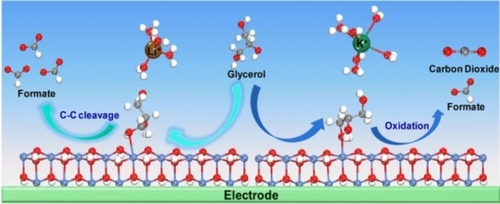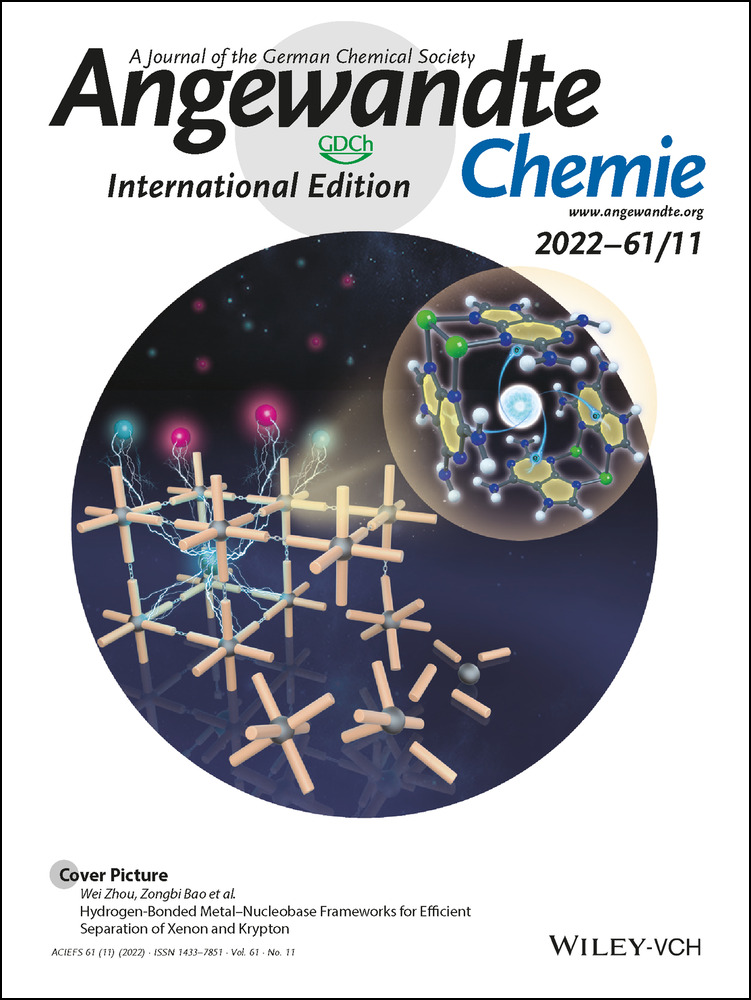Steering the Glycerol Electro-Reforming Selectivity via Cation–Intermediate Interactions
Jianxiang Wu
Department of Chemistry, Shanghai Key Laboratory of Molecular Catalysis and Innovative Materials, Fudan University, Shanghai, 200438 P. R. China
These authors contributed equally to this work.
Search for more papers by this authorJili Li
Department of Chemistry, Shanghai Key Laboratory of Molecular Catalysis and Innovative Materials, Fudan University, Shanghai, 200438 P. R. China
These authors contributed equally to this work.
Search for more papers by this authorCorresponding Author
Yefei Li
Department of Chemistry, Shanghai Key Laboratory of Molecular Catalysis and Innovative Materials, Fudan University, Shanghai, 200438 P. R. China
Key Laboratory of Computational Physical Science, Fudan University, Shanghai, 200438 P. R. China
Search for more papers by this authorXian-Yin Ma
Department of Chemistry, Shanghai Key Laboratory of Molecular Catalysis and Innovative Materials, Fudan University, Shanghai, 200438 P. R. China
Search for more papers by this authorWei-Yi Zhang
Department of Chemistry, Shanghai Key Laboratory of Molecular Catalysis and Innovative Materials, Fudan University, Shanghai, 200438 P. R. China
Search for more papers by this authorYaming Hao
Department of Chemistry, Shanghai Key Laboratory of Molecular Catalysis and Innovative Materials, Fudan University, Shanghai, 200438 P. R. China
Search for more papers by this authorWen-Bin Cai
Department of Chemistry, Shanghai Key Laboratory of Molecular Catalysis and Innovative Materials, Fudan University, Shanghai, 200438 P. R. China
Search for more papers by this authorZhi-Pan Liu
Department of Chemistry, Shanghai Key Laboratory of Molecular Catalysis and Innovative Materials, Fudan University, Shanghai, 200438 P. R. China
Key Laboratory of Computational Physical Science, Fudan University, Shanghai, 200438 P. R. China
Search for more papers by this authorCorresponding Author
Ming Gong
Department of Chemistry, Shanghai Key Laboratory of Molecular Catalysis and Innovative Materials, Fudan University, Shanghai, 200438 P. R. China
Search for more papers by this authorJianxiang Wu
Department of Chemistry, Shanghai Key Laboratory of Molecular Catalysis and Innovative Materials, Fudan University, Shanghai, 200438 P. R. China
These authors contributed equally to this work.
Search for more papers by this authorJili Li
Department of Chemistry, Shanghai Key Laboratory of Molecular Catalysis and Innovative Materials, Fudan University, Shanghai, 200438 P. R. China
These authors contributed equally to this work.
Search for more papers by this authorCorresponding Author
Yefei Li
Department of Chemistry, Shanghai Key Laboratory of Molecular Catalysis and Innovative Materials, Fudan University, Shanghai, 200438 P. R. China
Key Laboratory of Computational Physical Science, Fudan University, Shanghai, 200438 P. R. China
Search for more papers by this authorXian-Yin Ma
Department of Chemistry, Shanghai Key Laboratory of Molecular Catalysis and Innovative Materials, Fudan University, Shanghai, 200438 P. R. China
Search for more papers by this authorWei-Yi Zhang
Department of Chemistry, Shanghai Key Laboratory of Molecular Catalysis and Innovative Materials, Fudan University, Shanghai, 200438 P. R. China
Search for more papers by this authorYaming Hao
Department of Chemistry, Shanghai Key Laboratory of Molecular Catalysis and Innovative Materials, Fudan University, Shanghai, 200438 P. R. China
Search for more papers by this authorWen-Bin Cai
Department of Chemistry, Shanghai Key Laboratory of Molecular Catalysis and Innovative Materials, Fudan University, Shanghai, 200438 P. R. China
Search for more papers by this authorZhi-Pan Liu
Department of Chemistry, Shanghai Key Laboratory of Molecular Catalysis and Innovative Materials, Fudan University, Shanghai, 200438 P. R. China
Key Laboratory of Computational Physical Science, Fudan University, Shanghai, 200438 P. R. China
Search for more papers by this authorCorresponding Author
Ming Gong
Department of Chemistry, Shanghai Key Laboratory of Molecular Catalysis and Innovative Materials, Fudan University, Shanghai, 200438 P. R. China
Search for more papers by this authorGraphical Abstract
Glycerol oxidation selectivity can be efficiently steered via cation–intermediate interactions, resulting in highly selective glycerol electro-reforming into hydrogen and formate. This work emphasizes the significance of engineering the microenvironment at the electrode–electrolyte interface for efficient electrochemical processes.
Abstract
Electro-reforming of renewable biomass resources is an alternative technology for sustainable pure H2 production. Herein, we discovered an unconventional cation effect on the concurrent formate and H2 production via glycerol electro-reforming. In stark contrast to the cation effect via forming double layers in cathodic reactions, residual cations at the anode were discovered to interact with the glycerol oxidation intermediates to steer its product selectivity. Through a combination of product analysis, transient kinetics, crown ether trapping experiments, in situ IRRAS and DFT calculations, the aldehyde intermediates were discovered to be stabilized by the Li+ cations to favor the non-oxidative C−C cleavage for formate production. The maximal formate efficiency could reach 81.3 % under ≈60 mA cm−2 in LiOH. This work emphasizes the significance of engineering the microenvironment at the electrode–electrolyte interface for efficient electrolytic processes.
Conflict of interest
The authors declare no conflict of interest.
Supporting Information
As a service to our authors and readers, this journal provides supporting information supplied by the authors. Such materials are peer reviewed and may be re-organized for online delivery, but are not copy-edited or typeset. Technical support issues arising from supporting information (other than missing files) should be addressed to the authors.
| Filename | Description |
|---|---|
| anie202113362-sup-0001-misc_information.pdf2 MB | Supporting Information |
Please note: The publisher is not responsible for the content or functionality of any supporting information supplied by the authors. Any queries (other than missing content) should be directed to the corresponding author for the article.
References
- 1
- 1aM. S. Dresselhaus, I. L. Thomas, Nature 2001, 414, 332–337;
- 1bJ.-Y. Zhang, H. Wang, Y. Tian, Y. Yan, Q. Xue, T. He, H. Liu, C. Wang, Y. Chen, B. Y. Xia, Angew. Chem. Int. Ed. 2018, 57, 7649–7653; Angew. Chem. 2018, 130, 7775–7779;
- 1cP. Su, W. Pei, X. Wang, Y. Ma, Q. Jiang, J. Liang, S. Zhou, J. Zhao, J. Liu, G. Q. Lu, Angew. Chem. Int. Ed. 2021, 60, 16044–16050; Angew. Chem. 2021, 133, 16180–16186;
- 1dS. Anantharaj, S. Noda, V. R. Jothi, S. Yi, M. Driess, P. W. Menezes, Angew. Chem. Int. Ed. 2021, 60, 18981–19006; Angew. Chem. 2021, 133, 19129–19154;
- 1eX.-Y. Ma, W.-Y. Zhang, S.-Z. Zou, W.-B. Cai, J. Electrochem. 2021, 27, 233–256.
- 2
- 2aT. R. Cook, D. K. Dogutan, S. Y. Reece, Y. Surendranath, T. S. Teets, D. G. Nocera, Chem. Rev. 2010, 110, 6474–6502;
- 2bJ. Zhang, T. Wang, P. Liu, Z. Liao, S. Liu, X. Zhuang, M. Chen, E. Zschech, X. Feng, Nat. Commun. 2017, 8, 15437;
- 2cL. Han, S. Dong, E. Wang, Adv. Mater. 2016, 28, 9266–9291;
- 2dA. Goyal, M. T. M. Koper, Angew. Chem. Int. Ed. 2021, 60, 13452–13462; Angew. Chem. 2021, 133, 13564–13574.
- 3
- 3aC. Li, Y. Liu, Z. Zhuo, H. Ju, D. Li, Y. Guo, X. Wu, H. Li, T. Zhai, Adv. Energy Mater. 2018, 8, 1801775;
- 3bZ.-Y. Yu, C.-C. Lang, M.-R. Gao, Y. Chen, Q.-Q. Fu, Y. Duan, S.-H. Yu, Energy Environ. Sci. 2018, 11, 1890–1897;
- 3cX. Wei, S. Wang, Z. Hua, L. Chen, J. Shi, ACS Appl. Mater. Interfaces 2018, 10, 25422–25428;
- 3dW. Zhu, M. Ren, N. Hu, W. Zhang, Z. Luo, R. Wang, J. Wang, L. Huang, Y. Suo, J. Wang, ACS Sustainable Chem. Eng. 2018, 6, 5011–5020;
- 3eY. Li, X. Wei, L. Chen, J. Shi, M. He, Nat. Commun. 2019, 10, 5335;
- 3fC. Tang, R. Zhang, W. Lu, Z. Wang, D. Liu, S. Hao, G. Du, A. M. Asiri, X. Sun, Angew. Chem. Int. Ed. 2017, 56, 842–846; Angew. Chem. 2017, 129, 860–864.
- 4
- 4aG. Dodekatos, S. Schünemann, H. Tüysüz, ACS Catal. 2018, 8, 6301–6333;
- 4bC.-H. Zhou, J. N. Beltramini, Y.-X. Fan, G. Q. Lu, Chem. Soc. Rev. 2008, 37, 527–549.
- 5J.-X. Wu, S.-Z. Hou, X.-D. Zhang, M. Xu, H.-F. Yang, P.-S. Cao, Z.-Y. Gu, Chem. Sci. 2019, 10, 2199–2205.
- 6
- 6aH. Wang, L. Thia§, N. Li, X. Ge, Z. Liu, X. Wang, ACS Catal. 2015, 5, 3174–3180;
- 6bS. Lee, H. J. Kim, E. J. Lim, Y. Kim, Y. Noh, G. W. Huber, W. B. Kim, Green Chem. 2016, 18, 2877–2887;
- 6cY. Kim, H. W. Kim, S. Lee, J. Han, D. Lee, J.-R. Kim, T.-W. Kim, C.-U. Kim, S.-Y. Jeong, H.-J. Chae, B.-S. Kim, H. Chang, W. B. Kim, S. M. Choi, H. J. Kim, ChemCatChem 2017, 9, 1683–1690.
- 7X. Han, H. Sheng, C. Yu, T. W. Walker, G. W. Huber, J. Qiu, S. Jin, ACS Catal. 2020, 10, 6741–6752.
- 8
- 8aS. Ringe, E. L. Clark, J. Resasco, A. Walton, B. Seger, A. T. Bell, K. Chan, Energy Environ. Sci. 2019, 12, 3001–3014;
- 8bA. S. Malkani, J. Li, N. J. Oliveira, M. He, X. Chang, B. Xu, Q. Lu, Sci. Adv. 2020, 6, eabd2569;
- 8cY. Zhong, Y. Xu, J. Ma, C. Wang, S. Sheng, C. Cheng, M. Li, L. Han, L. Zhou, Z. Cai, Y. Kuang, Z. Liang, X. Sun, Angew. Chem. Int. Ed. 2020, 59, 19095–19101; Angew. Chem. 2020, 132, 19257–19263;
- 8dS. Banerjee, X. Han, V. S. Thoi, ACS Catal. 2019, 9, 5631–5637;
- 8eA. S. Malkani, J. Anibal, B. Xu, ACS Catal. 2020, 10, 14871–14876;
- 8fS. Kaneco, H. Katsumata, T. Suzuki, K. Ohta, Energy Fuels 2006, 20, 409–414;
- 8gM. R. Singh, Y. Kwon, Y. Lum, J. W. Ager, A. T. Bell, J. Am. Chem. Soc. 2016, 138, 13006–13012;
- 8hC. Yang, O. Fontaine, J.-M. Tarascon, A. Grimaud, Angew. Chem. Int. Ed. 2017, 56, 8652–8656; Angew. Chem. 2017, 129, 8778–8782.
- 9
- 9aS. Banerjee, Z.-Q. Zhang, A. S. Hall, V. S. Thoi, ACS Catal. 2020, 10, 9907–9914;
- 9bC. M. Gunathunge, V. J. Ovalle, Y. Li, M. J. Janik, M. M. Waegele, ACS Catal. 2018, 8, 7507–7516;
- 9cE. Pérez-Gallent, G. Marcandalli, M. C. Figueiredo, F. Calle-Vallejo, M. T. M. Koper, J. Am. Chem. Soc. 2017, 139, 16412–16419;
- 9dJ. Resasco, L. D. Chen, E. Clark, C. Tsai, C. Hahn, T. F. Jaramillo, K. Chan, A. T. Bell, J. Am. Chem. Soc. 2017, 139, 11277–11287.
- 10X. Meng, D. Deng, J. Mater. Chem. A 2016, 4, 6919–6925.
- 11D. Lim, S. Kim, N. Kim, E. Oh, S. E. Shim, S.-H. Baeck, ACS Sustainable Chem. Eng. 2020, 8, 4431–4439.
- 12C. Dai, L. Sun, H. Liao, B. Khezri, R. D. Webster, A. C. Fisher, Z. J. Xu, J. Catal. 2017, 356, 14–21.
- 13L. Wang, S. A. Nitopi, E. Bertheussen, M. Orazov, C. G. Morales-Guio, X. Liu, D. C. Higgins, K. Chan, J. K. Nørskov, C. Hahn, T. F. Jaramillo, ACS Catal. 2018, 8, 7445–7454.
- 14
- 14aC. M. Choi, J. Heo, N. J. Kim, Chem. Cent. J. 2012, 6, 84;
- 14bZ. Jing, G. Wang, Y. Zhou, D. Pang, F. Zhu, H. Liu, J. Mol. Liq. 2020, 311, 113305;
- 14cJ. Li, D. Wu, A. S. Malkani, X. Chang, M.-J. Cheng, B. Xu, Q. Lu, Angew. Chem. Int. Ed. 2020, 59, 4464–4469; Angew. Chem. 2020, 132, 4494–4499.
- 15X. Yang, J. Nash, N. Oliveira, Y. Yan, B. Xu, Angew. Chem. Int. Ed. 2019, 58, 17718–17723; Angew. Chem. 2019, 131, 17882–17887.
- 16Y. Hao, Y. Li, J. Wu, L. Meng, J. Wang, C. Jia, T. Liu, X. Yang, Z.-P. Liu, M. Gong, J. Am. Chem. Soc. 2021, 143, 1493–1502.
- 17J. Blaney, J. Dixon, Vol. 1, 2007, pp. 299–335.





